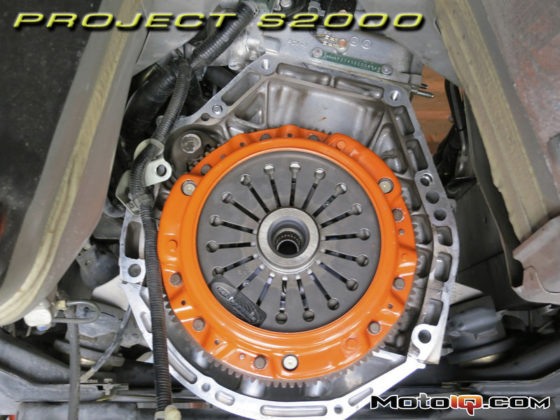,

Tyler then plotted some points to create a simple model of both heads mounted on a block and then lined the ports up between the head and stub manifold in CAD. A simple measurement in CAD told us how thick the new gasket needed to be. Using the HR or VVEL stub manifolds weren't options because of different bolt patterns on both the head and intake manifold sides. The engines use Cosworth intake plenums originally designed for a DE.

As luck would have it, it was not a standard thickness material. The exact thickness is in my notes somewhere, but it was available special order. Then the phenolic material was cut by water jet to match the ports of the Cosworth CNC heads.

Here Tyler and Katsu do the final assembly of the the real engine. Engine #1 is kind of a mule more designed for testing and development than ultimate ass kicking. I'm sure it will still easily make in the neighborhood of 750whp/700lb-ft torque without having to work too hard. The BorgWarner EFR-9180 turbo certainly would be cruising. In fact, we may even be able to drop the turbo size down to an EFR-8374 if we do not need the power. The entire assembly with transmission, transfer case, front diff, front subframe, and front suspension is all installed at the same time. The original idea was to have two complete assemblies ready to change if needed, but we've only concentrated on the first one so far. After some testing to make sure everything works as it was designed to, we can always duplicate the parts then.

Here's the BorgWarner EFR-9180's compressor map. It can deliver a maximum of 95 lb/min. of mass flow. At somewhere between 10-10.5 horspower per lb/min. of mass flow (depending on your engine), we're talking about a maximum of approximately 950-1000 horsepower for the EFR-9180. The really nice thing about the EFR series compressors is how wide the maps are which means the efficiency islands are wider as well making them very efficient across a broad range of mass flow and pressure ratios. For those of you who came to MotoIQ a bit later, check out this article I wrote a while back: BorgWarner EFR Turbo Feature Set.

Notice in the picture of Tyler and Katsu prepping the engine that there are no accessories on it. The reason for that is that we'll be using a factory Toyota SW20 power steering pump that's mounted where the passenger side rear seats used to be and that we are using no alternator. The dry sump oil pump went on a little later. The Braille Battery B128L pictured on the right weighs in at only 8 lbs (3.63Kg). The 25 Amp Braille lithium charger will charge the 30AH (amp hours) B128L in just over an hour assuming a full discharge. While physically larger than an Odyssey PC680MJT that weighs in at 16lbs, two Braille B128Ls also weigh 16lbs with the added benefit of being able to put the two in separate locations to shift weight around in a race car. Here's the kicker: a single Odyssey PC680 has a capacity of 17AH while the two Braille B128Ls have a total capacity of 60AH or nearly four times the total capacity at the same weight. Sure, the Braille's cost a whole lot more, but nobody said race cars were cheap right?

At 900 cranking amps, the B128L will have no problems starting a VQ35 in any weather. In fact, that's more cranking amperage than the full sized Group 35 sized Odyssey PC1400 I have in my G35 does and that sucker weighs 46 lbs! With dimensions of only 10″L x 3.25″W x 6.8″H, the B128L is a very compact battery considering their capacities. For something a bit more affordable, check out the new Braille GU1R Lithium Ion battery that was just unveiled at SEMA. It's from Braille's entry level line of Lithium batteries called the Green Lite and the GU1R is designed as a direct replacement for a Mazda Miata battery (perfect for your Miata Cup guys). The great thing is that it is only 6.6lbs with a capacity of 13AH. With 950 cranking amps, it will start almost anything up to a V8 too. What a perfect coincidence that I use a Miata battery in my street BNR32 GT-R… Anyhow, the ARK BNR32 will be running two Braille B128L batteries in parallel.

After talking to Blake and Gary at Braille, I am convinced that charging systems are unnecessary in Time Attack with Lithium Ion technology. At full discharge the B128Ls will still have an output of 11.2 volts which means that almost the entire capacity of the battery will allow the car to run at maximum performance. At peak current draw, the GT-R's electrical system should draw approximately 129 Amps. With 60AH of reserve capacity on board from the two B128L batteries, that would be at least 30 minutes of run time at max draw. Of course since the engine is not always sitting at redline with the ignition coils, fuel injectors, and fuel pumps at maximum current draw, the two B128L batteries should give plenty more than 30 minutes of run time. Besides, the 8 gallon fuel cell isn't going to even last three hot laps at Eastern Creek. Perhaps in the future, we'll remove one of the B128Ls for further weight reduction.

Here's a factory 110A 350Z VQ35DE alternator. When we were planning to run an alternator, I modified a Cosworth Formula Atlantic alternator pulley to fit so that the alternator would be underdriven about 30%. This alternator with the stock pulley weighs in at 14.2 lbs.


